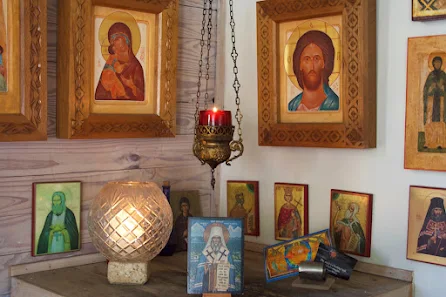Why does it matter? And where to get them from when you decide what you want.
For those of you who have an icon or image corner in your domestic church, you are accustomed to having to decide how to provide flame, safely, for your icon corner. The burning flame is a symbol of the Light of the World which becomes also a sign that, when lit, the household is in prayer time.
It is also an important addition to the aesthetics. The flickering light is attractive in itself and renders the icons more beautiful through reflective interplay of light and dark. Also, if you have children, you will know that the presence of fire adds a focus that draws their attention to it, as powerfully as if they were moths.
So here are the options that I have considered. I’ll start with the one that I prefer, which is an oil burning lamp.
I bought this ‘lampada’ from
Byzantine Catholic Supplies, which mailed it to me from their shop in Philadelphia. Along with this standing lampada, I bought the lamp, wick holders, wick and paraffin. They don’t have to be as ornate as this one - it is possible to buy the colored glass only and that will work perfectly well. Purists will insist upon olive oil as the fuel. Whichever fuel you use - the children of one Byzantine Catholic family did an experiment with a range of vegetable oils and found that crisco was the most cost efficient! - this will provide a constant flame reliably and as needed in an attractive setting. It is many hours before you will need to top up the fuel, and many more before you will need to replace the wick.
Many prefer the hanging lampada,
this photo comes from a site by an Orthodox writer on how to set up an icon corner.
I rejected the hanging variety simply because of the practicalities. I was reluctant to start drilling or pinning things to my ceiling!
Candles
I always used to have candles, but found that however hard I tried, at some point wax would drip onto the surface or on the floor.
The reasonably priced options for candles are tapered beeswax or Tea lights.
Tapered beeswax candles, are bought by weight, typically, rather than by number.
Byzantine Church Supplies charges $12 for a pound, at the time of writing. The advantage of these thin candles is, provided you have something to stand them in and they are vertical, as they burn down the flame consumes all the wax, so there is no rivulet of molten wax to deal with.
Tea lights are also cheap, clean and convenient and can be ordered in bulk from Amazon, but tend look ugly unless you can find an attractive low-rimmed container to put them in. Also, just as with the tapered beeswax candles, they burn quickly and so steadily need replacing regularly.
.jpg)
Then you have large candles, which often come scented. These look lovely when you first light them but I have never been able to stop the effect of tunneling - the center burning down while leaving the outer ring unmelted. The effect of tunnelling is increased if you burn wide candles for less than an hour, which I would do often if I was using it in an icon corner. So usually I end up with a deeply buried flame or I trim excess wax off the height of the candle with a warm knife so that I can see it, which wriles me as a feel its just a waste of the wax that I feel ought to be used. The candles that are enclosed in jars, will burn more evenly provided that you can burn long enough for the whole of the top layer to melt and become liquid.
There is probably something I could do to improve this but I never found and answer and in the end abandoned the project and opted for the standing lampada.







.jpg)

